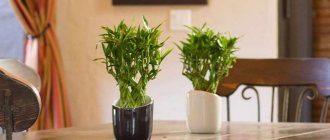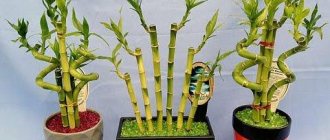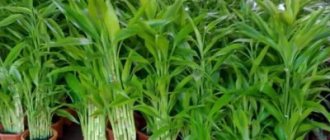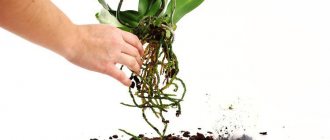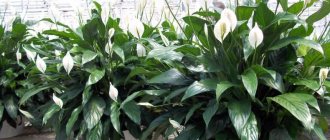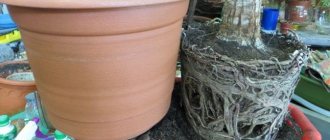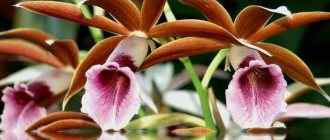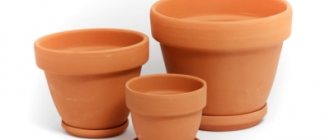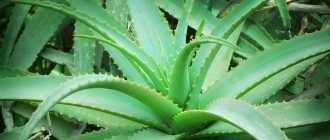- September 22, 2019
- Houseplants
- Maria Vetoshkina
Flower growers love to grow bamboo, because it is easy to care for and you can create a variety of unique compositions from it. At the same time, bamboo is planted differently, and each method has its own advantages. That is why information on how to replant bamboo at home will be of interest to many.
Transfer rules
Bamboo shoots are best germinated in water. They should be transplanted into the ground when the roots reach 4-5 cm. Bamboo cuttings with small roots do not take root well, and roots that are too long are easy to damage during planting. It is necessary to remove the cuttings from the water before planting.
You can use any rooting agent; you just need to sprinkle it on the damp roots. A pot of soil must be prepared in advance; a hole in the soil must be made slightly larger than the rhizome.
The soil should be added in small portions until the pot is filled. The soil should not be compacted too much to avoid damaging the young roots.
After planting, the cuttings are watered and, if necessary, soil is added. In order for the young shoot to take root better, it can be sprayed with water in the first week.
Home plant
Not everyone knows that indoor bamboo is not related to the bamboo that grows in the wild. At home, we grow one of the varieties of a very popular crop - dracaena, or, to be more precise, Dracaena Sander.
The plant is a bare stem with several leaves at the top. The trunk can be straight or bent in a spiral. Typically, indoor bamboo is painted bright green. Sometimes there are golden-colored plants. If the crop is exposed to bright sun during the day, its color becomes dark green.
Many gardeners ask the question: “Is it possible to grow bamboo at home?” After all, it is considered a plant that brings good luck and happiness. Apparently, for this reason the plant is popular. If you place bamboo in the southeastern part of the house, you will certainly be blessed with good luck and financial stability.
Selecting a site and preparing for transplantation
Before transplanting, you need to prepare everything you need. To do this you will need: a planting container, soil, drainage material, and a means for rooting the flower.
The choice of location also needs to be approached carefully. Bamboo came to us from tropical forests, where the climate is humid and warm. Therefore, a bamboo indoor plant will do well in a warm and well-lit corner. He only needs diffused light; light partial shade is also suitable. The most comfortable temperature is considered to be from 20 to 25 degrees. In the room where bamboo grows, the air should not stagnate.
Myths and beliefs
It is not known for certain who was the first to call Dracaena Sander the Bamboo of Happiness, and it doesn’t matter: the plant brings joy to the house and that’s enough. According to the Chinese philosophy of Feng Shui, bamboo attracts wealth and health into the home.
The number of stems also matters:
- Three stems will give you peace of mind.
- Five - will attract money.
- Seven - will ensure health.
- Twenty is happiness in love and family life.
- Twenty-one - all the blessings combined.
However, Lucky bamboo is not bamboo at all, so what do Chinese signs have to do with it?
But in fact, it doesn’t really matter whether this is an invention of cunning marketers or the legend has a basis: a thought, as we know, is material and all good things will definitely come true!
Soil and pot for the plant
In what soil should I plant bamboo? This plant belongs to the dracaena family, so for planting it, a ready-made soil mixture specially designed for dracaenas is best suited. It can be purchased at a specialty store.
The container for planting bamboo can be anything, the main thing is that it must meet two requirements:
- The diameter of the pot should be approximately twice the size of the plant's rhizome.
- The pot must have drainage holes.
The plant will look very impressive in a beautiful vase if its stems are additionally tied with a bright ribbon.
Features and methods of reproduction
If you already have one pot of indoor bamboo in your house and you need to propagate it, you can do this in several ways. In this case, many factors are taken into account that influence the further development of the plant. You can also use the seed propagation method. But most often they resort to the method of increasing plantings by separating shoots from an adult healthy sample. The method is simple, does not require any extra knowledge or skills, and can be successfully implemented at home.
Cuttings, in turn, are divided into several more types:
- apical;
- stem;
- knees.
The apical cutting method is performed by cutting a 15 cm long apex from the mother stem. The cut part is placed in water, a growth stimulator is added and the roots are waited for. To prevent stem rotting, all cut areas are lubricated with liquid wax.
With the stem cutting method, root development also occurs in water with a growth stimulator. The adult stem is cut into pieces and processed. This method of reproduction is used when the previous one failed.
Reproduction by knees is not a particularly popular method, despite its effectiveness. It is used if an old plant with a weakened root system needs saving. The stem is placed in water. When measles begin to appear at the junction of the segments, this part is separated from the general shoot and transplanted into the ground.
Seed propagation of indoor bamboo is a simple technique. Suitable for woody varieties. Planting material is purchased at any specialized store. It is soaked for 12 hours in clean water to swell. At this time, the soil is prepared. Mix fine wood shavings with soil in a ratio of 1:8. One part of wood ash is also added there.
The substrate is sifted, moistened and poured into containers. In each, make a depression of about 4 cm and place one seed there. The seeds must first be dried with a paper towel and left for 15 minutes to dry naturally. As many seeds as you decide to plant, so many containers need to be prepared.
The crops are covered with substrate, and the containers are placed in partial shade. Until the first shoots appear, maintain a sufficient level of soil moisture. From the moment of planting until the shoots appear, at least 2 weeks must pass. Sometimes the process stretches out to almost a month.
How to replant bamboo in an apartment
Bamboo is an unpretentious plant; it grows well in water, in soil, and in hydrogel. But he will feel best in the ground.
The process of planting bamboo in a pot is as follows:
- For planting, you need to choose healthy, richly green seedlings that have living, undamaged roots.
- It is better to choose a pot deep enough and spacious enough so that the roots have room to grow. Particular attention should be paid to the drainage holes to ensure the outflow of water from the container.
- The soil, as mentioned above, must be taken ready-made. Expanded clay or small pebbles are suitable for drainage.
- Water for irrigation should be melted or settled.
The drainage layer should be at least 3 cm; moistened soil is placed on it in small portions and a hole is immediately made. The cuttings are taken out of the water, a preparation for root growth should be sprinkled on the roots and a little of this preparation should be added to the hole itself.
The roots are sprinkled with earth, compacted a little, and the pot is completely filled with soil. Water thoroughly so that water flows out through the drainage holes. Water must be removed from the pan so that it does not stagnate.
Nuances of care
Bamboo planted at home requires regular care. Then it will delight you with its fresh appearance, green stems and leaves, and at certain times, beautiful flowering. Activities boil down to watering, moistening the foliage, fertilizing and pruning an adult plant.
Watering
Water bamboo only with settled water at room temperature. If you moisten the soil with ordinary tap water, then the harmful impurities contained in it will have a detrimental effect on the development of the crop. A weakened plant will become a target for attacks by pests and diseases.
In addition to settled water, you can use frozen water. This way it softens and cleans up a little. The frequency of watering bamboo varies depending on the time of year. When it is warm, it is necessary to moisten the soil more often. During the autumn-winter period, watering should be moderate. With the arrival of cold weather, the plant is transferred to independent control of its moisture needs by transplanting it into a vase with water.
Water the bamboo through a tray. The roots themselves will take as much moisture as they need. After 3-4 hours, the water is drained. You can tell when it’s time to water your dracaena by the appearance of the soil surface. It is impossible to water at the root. Also, do not overly moisten the leaves and stem of the plant. This will lead to the formation of rot on the roots. If a putrid odor emanates from the soil, watering is temporarily stopped.
Transfer
Bamboo grows quite quickly and develops its root system. When the roots reach 5 cm in length, the crop can be replanted. To do this, the cuttings are placed in water and left in a lighted place. Rhizomes that are too long are pruned because... they can get tangled and break off at the very base.
The transplant procedure is as follows:
- the cuttings are removed from the water and treated with a rooting agent;
- the sprout is placed in the hole, gradually adding and compacting the soil;
- The top layer of soil should be flush with the edge of the pot. As it settles after watering, it is added.
It is best to replant bamboo in early spring. This will give the root system time to develop and strengthen. The pot is taken deeper and wider than the previous one.
Top dressing
Even the most nutrients should be in moderation. Excessive fertilizer for bamboo will only cause harm. If the plant is planted in the ground, it is fed once a month, starting in spring. In the summer, the amount of fertilizer is kept to a minimum, but they are applied a little more often than once a month.
Nitrogen-based products can be used to feed bamboo
For feeding decorative dracaena, universal mixtures for palm trees and deciduous perennials are suitable. If it grows in water, then its nutrition should be complete and frequent. For this purpose, liquid products based on nitrogen and phosphorus are used. If there is no need for rapid growth of bamboo, the dosage is reduced several times from that indicated on the package.
Trimming
Decorative bamboo is a unique plant, the stems of which can be used to form any shape. Flexible shoots tolerate pruning well. It is carried out as needed. First of all, get rid of dried leaves and stems at the base. Having chosen a branching point, cut below its mark.
Cuttings are used for rooting. Small cuts in the lower part of the stem will help speed up the process of root emergence.
Disease Prevention
Bamboo has good immunity and practically does not get sick. The only thing that can happen to it is yellowing of the leaves and fading of the stem. Damage to the plant can be caused by excessive or improper care. For example, constant intense lighting, watering with dirty water or lack of drainage. This leads to the formation of rot, fungus and bacteria. If small spots appear on the leaves, cut them off immediately. The cut area is treated with charcoal, and after a couple of hours it is covered with wax.
Bamboo is rarely susceptible to pest attacks. Sometimes it can harbor spider mites. You can get rid of it by treating it with soapy water.
Possible problems
The above describes in detail how to replant bamboo, but after replanting the following problems may arise:
- The tips of the leaves dry out. Dry air or lack of heat is to blame for this.
- The leaves begin to turn yellow. If the leaves turn yellow slowly and infrequently, then this can be considered a natural process. If the leaves turn yellow constantly, this indicates a lack of nutrition; the plant needs to be fed.
- The leaves are curling up. This may be due to low temperature.
- Spots appear on the leaves: yellow-brown or dry. They can be caused by direct sunlight.
Caring for indoor bamboo
Caring for the Bamboo of Happiness comes down to regular watering and spraying: the plant does not tolerate drought well. In winter, weekly watering is sufficient.
The surprisingly unpretentious plant does not need feeding, however, if the leaves begin to turn yellow, then this is a danger signal: the plant does not have enough nutrition. Therefore, to prevent diseases in winter and summer, bamboo is fed with mineral and/or organic fertilizers.
Lighting, humidity and temperature
Proper lighting is important for any plant. Bamboo, like other dracaenas, loves bright rooms, but direct sunlight will not benefit the plant. Direct sun may cause burns on the leaves. The flower will feel good in diffused sunlight. It will grow in partial shade, but insufficient lighting inhibits growth, and in this case the leaves may turn pale.
Bamboo is a tropical plant, so dry air is unacceptable for it. To humidify the air around the plant, you can place containers of water nearby, or use a special humidifier. The flower will also appreciate daily spraying.
Homemade bamboo loves warmth very much. In an ordinary apartment he will be quite comfortable, you just need to make sure that the air temperature does not drop below 20 degrees. The room where the plant is located can, and even should, be ventilated, but bamboo does not like drafts.
Thus, if you follow the conditions of keeping the plant, then planting bamboo, as described above, will not be difficult, because the plant will be healthy and strong.
Types and varieties for indoor growing
Bamboo is an exotic representative of the flora and does not grow on its own in domestic latitudes. He loves light, warmth and moisture, so the climate of the tropics and subtropics is closer to him. But with the help of breeders, it became possible to plant bamboo in Russian areas. There are frost-resistant species that can withstand frosts of 20 degrees and below. Bamboo began to be grown not only in garden plots, but also at home.
Indoor decorative bamboo is a small plant that grows in pots, water or a special hydrogel. It is also called Dracaena Sandera. Its external features are a bare stem with lanceolate leaves at the top. Bamboo grows quite quickly. Under natural conditions, it can stretch 70 cm in a day. If you do not follow the pruning rules, even a houseplant will reach 1 meter in height.
Decorative bamboo has a hollow stem and grows in different directions. This makes it possible to give it various design forms and create beautiful compositions with its participation.
Decorative culture is divided into the following types:
- low plants - up to 1 meter;
- medium - up to 3.5 m;
- high - up to 6 meters. They are not often, but they are still planted at home if the space allows.
As for varieties, the following are suitable for home planting:
- variegated multiflorum "Fortune";
- golden multiflorum 60-70 cm high;
- dwarf plants up to 45 cm;
- Kuril bamboo or Kuril aza 30-100 cm high;
- "Arundinaria Muriel" - light yellow stem up to 3 m;
- "Arundinaria variegated." - creamy-green stem up to 1 m in height.
Bamboo Arundinaria Muriel
When choosing a variety, take into account the ability of bamboo to grow singly or in groups, because Not all plants like privacy. It is also necessary to pay attention to the height of an adult seedling, the shape of its leaves, the type of root system, etc.
Plant pests and diseases
A healthy flower is practically not affected by diseases and pests. The latter include spider mites and mealybugs.
The first entangles the leaves with a cobweb. Spraying with Aktara helps combat it.
Mealybug appears as white lumps in the leaf axils. These lumps need to be removed and then treated with the Actellik insecticide.
The following diseases can be noted:
- Dark spots on the leaves are a fungal disease. It is necessary to treat the plant with a fungicide and ventilate the room more often.
- Slow growth - the plant lacks minerals. You need to feed it with a complex product.
- The leaves become dark and soft - the temperature in the room is too low, it needs to be increased.
Growing in open ground
Before planting bamboo, you need to evaluate the conditions for the plant's growth. This is done according to five main criteria:
- Variety
- Lighting
- windiness
- Temperature
- The soil
When choosing a variety, you need to clearly understand for what purposes it will be planted. Here its height and the shape of the leaves will be important. Some species look good alone, others need to be planted in groups.
It is important to analyze the temperature of the climate zone. There are varieties that can withstand frosts down to -28 degrees, and some will die at -15. Otherwise, the plant will die at the first frost, all efforts will be in vain.
Bamboo is not fussy. Despite this fact, it receives nutrition through the root system from the soil.
Therefore, the more nutritious it is, the better it will grow and develop. If the soil is poor, it needs to be enriched with fertilizer. Dense soil will slow down growth, but such soil freezes less easily. In the cold season, this feature will save the roots from freezing.
Many varieties of bamboo love sunlight. There are also shade-tolerant varieties. It grows faster and develops better in the sun. In winter, it depletes the plant. In the dry climate of the planting region, it is better to choose a place in partial shade.
Bamboo does not tolerate wind. Therefore, before planting a plant, it is important to come up with a protective barrier against it.
Watering rules
Many beginners believe that bamboo is a drought-resistant plant and does not need to be watered. Friends, this is a mistaken opinion. The ornamental plant loves water very much, and a deficiency will not allow it to take root in a new place. In order for bamboo to acclimatize to new conditions, follow these rules:
- Water the plant after planting in the ground as often as possible for 3-6 months.
- Fill the plant in the pot with 5 cm of water once every 10 days.
- To retain moisture, use mulch, this is ideal for those who forget to water.
- Touch the soil with your hand, if it is dry, water it.
- Drain excess water from the pan; excessive waterlogging damages the root system and it begins to rot.
- Watch the bamboo; if the leaves are curled, it means it needs watering; if they turn yellow, reduce the quantity and rate.
- Use only purified or settled water; in the water pipe it contains chlorine, this is death for the plant.
Author's note
Natalia Papanova
Blog author
For irrigation, use melt water. Fill a plastic bottle with regular tap water and place it in the freezer.
Watch a video about home care for Dracaena Sandera:
Bamboo propagation
Indoor bamboo practically does not reproduce by seeds; it is too difficult and time consuming to grow seedlings in this way.
Cuttings are considered a more productive method of propagation. For these purposes, young shoots are used; they are cut in the spring from the main stem of a mature plant. The cuttings are separated without damaging them and planted in moist soil for rooting.
The composition of the soil is described above. Drainage is placed at the bottom of the planting container. In order not to have to replant the plant after 1-2 years, place the seedling in a large pot. The size of the cutting does not matter.
Cuttings are carried out together with transplanting the plant into a new container, 3-5 cm larger in diameter and depth than the previous one. It is better to do this in the spring. Cuttings adapt well and take root with proper care. Do not allow the wet ball to dry out.
Getting plants from sticks
How to grow bamboo at home from such material? Very often, florists use bamboo sticks to arrange beautiful bouquets. Flowers fade very quickly, but decorative elements can be used to create a plant. Experts believe that you can get a full-fledged dracaena from sticks. They should be placed in a vase with water and wait until the roots appear.
Next, young plants can be planted in the ground or left in vases with water for further cultivation. The first method is more correct. Thanks to it, you can get a full-fledged plant that will grow well for a long time in your home.
Features of care in winter
- In winter, the air in a heated room is drier, and in order for the plant to tolerate this more easily, watering is reduced.
- Due to the dry air, it is recommended to keep bamboo away from heating appliances.
- Hypothermia also has a bad effect on the well-being of the “lucky bamboo”, so you should move it from the window sills, and when ventilating the room, protect it from drafts.
- In long cloudy weather, when there is not enough natural light, it will not be superfluous to additionally illuminate the plant with fluorescent lamps. Especially if the leaves drooped and began to fall off, and the trunk turned yellow.
What fertilizers are needed for normal growth of bamboo at home?
The houseplant is unpretentious; any mineral fertilizers with nitrogen-phosphorus content are suitable for dracaenas. If you do not add organic ingredients, the tips of the bamboo leaves will gradually turn yellow or straw-colored, then dry out and fall off. I described how to prevent this in another article. Be sure to read it!
Is it correct to use phosphorus fertilizers?
Yes No, what are you talking about!
